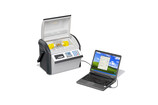DPA 75 C
Oil breakdown voltage tester
Insulating oil testing with the BAUR DPA 75 C
The BAUR DPA 75 C oil tester developed especially for mobile use in the field is one of its kind in the market due to its functionality and excellent user benefits in comparison to the costs. The BAUR DPA 75 C delivers clear and reliable measurement results.
- Compact and robust device for portable use onsite
- Test voltages from 0 to 75 kVrms
- Repeatable breakdown measurements in mineral, silicone and plant oils
- Reliable measurement results due to its short switch-off time (< 10 μs)
Product information
Literature
Supplementary:

DTL C
Oil tan delta and resistivity tester

Report Manager
External USB interface
for BAUR oil testers

BAUR ITS Lite software
Measurement data management
for oil testers
Other interesting products:

DTA 100 C
Oil breakdown voltage tester














